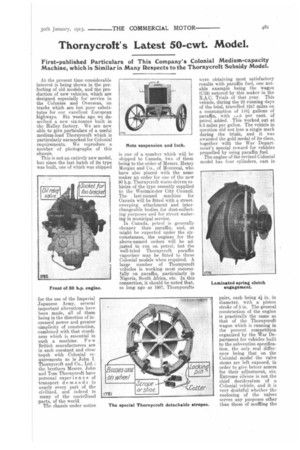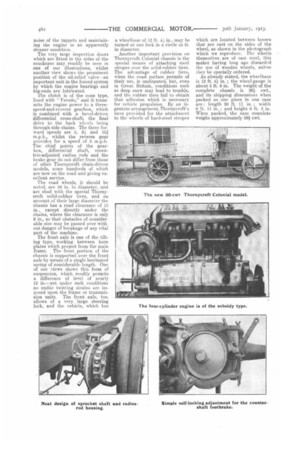Thornycroft' s Latest 50-cwt. Model.
Page 21

Page 22

If you've noticed an error in this article please click here to report it so we can fix it.
First-published Particulars of This Company's Colonial Medium-capacity Machine, which is Similar in Many Respects to the Thornycroft Subsidy Model.
At the present time considerable interest is being shown in the perfecting of old models, and the production of new vehicles, which are designed especially for service in the Colonies and Overseas, on tracks which are but poor substitutes for our excellent European highways. Six weeks ago we described a new six-tanner built in the Halley factory. We are now Able to give particulars of a useful medium-load Thornycroft which is particularly earmarked for Colonial requirements. We reproduce a number of photographs of this chassis.
This is not an entirely new model, but since the last batch of its type was built, one of which was shipped for the use of the Imperial Japanese Army, several important alterations have been made, all of them being in the direction of increased power and greater .simplicity of construction, 'combined with that sturdiness which is essential in such a machine. F e w British manufacturers are in such constant and close touch with Colonial requirements as is John I. 'Thornycroft and Co., Ltd. ; the brothers Messrs. John and Tom Thornycroft have personal exper ien c e of transport demands in nearly every part of the civilized, and indeed in many of the uncivilized parts, of the world. The chassis under notice is one of a number which will be shipped to Canada, two of them being to the order of Messrs. Henry Morgan and Co., of Montreal, who have also placed with the same maker an order for one of the new 30 h.p. Thornycreft worm-driven vehicles of the type recently supplied to the Westminster City Council. The last-named machine for Canada will be fitted with a streetsweeping attachment and interchangeable bodies for dust-collect ing purposes and for street-watering in municipal service.
In Canada, petrol is generally cheaper than paraffin, and, as might be expected under the circumstances, the engines for the above-named orders will be adjusted to run on petrol, but the well-tried Thornycroft paraffin vaporizer may be fitted to these Colonial models when required. A large number of Thornycroft vehicles is working most successfully on paraffin, particularly in Nigeria, South Africa, etc. In this connection, it should be noted that, so long ago as 1907, Thornycrofts were obtaining most satisfactory results with paraffin fuel, one notable example being the wagon (C19) entered by this maker in the R.A.C. Trials of that year. This vehicle, during the 22 running days of the trial, travelled 1247 miles on a consumption of 116f gallons of paraffin, with 10.5 per cent. of petrol added. This worked out at 9.3 miles per gallon. The vehicle in question did not lose a single mark during the trials, and it was awarded the gold medal of its class, together with the War Department's special reward for vehicles propelled by using paraffin fuel. The engine of the revised Colonial model has four cylinders, cast in pairs, each being 44 in. in diameter, with a piston stroke of 5 in. The general construction of the engine is practically the same as that of the Thornycroft wagon which is running in the present competition organized by the War Department for vehicles built to the subvention specification, the only real difference being that on the Colonial model the valve stems are left exposed, in order to give better access for their adjustment, etc. Extreme silence is not the chief desideratum of a Colonial vehicle, and it is very doubtful whether the enclosing of the valves serves any purposes other than those of muffling the noise of the tappets and maintaining the engine in an apparently cleaner condition.
The very large inspection doors which are fitted in the sides of the crankcase may readily be seen in one of our illustrations, whilst another view shows the prominent position of the oil-relief valve—an important unit in the forced system by which the engine bearings and big-ends are lubricated.
'fhe clutch is of the cone type, lined with "Ferodo," and it transmits the engine power to a threespeed-and-reverse gearbox, which is combined with a bevel-driven differential cross-shaft, the final drive to the back wheels being through side chains. The three forward speeds are 5, 91 and 15i. m.p.h., whilst the reverse gear provides for a speed of 5 m.p.h. The chief points of the gearbox differential shaft, eccentric-adjusted radius rods and the brake gear do not differ from those of other Thornyeroft chain-driven models, some hundreds of which are now on the road and giving excellent service.
The road wheels, it should be noted, are 40 in. in diameter, and are shod with the special Thornycroft solid-rubber tires, and on account of their large diameter the chassis has a road clearance of 13 in., except directly under the chains, where the clearance is only 9 in., so that obstacles of considerable size may be passed over without danger of breakage of any vital part of the machine.
The front axle is one of the tilting type, working between horn plates which project from the main frame. The front portion of the chassis is supported over the front axle by means of a single laminated spring of considerable length. One of our views shows this form of suspension, which readily permits a difference of level of nearly 12 in.—yet under such conditions no undue twisting strains are imposed upon the frame or transmission units. The frent axle, too, allows of a very large steering lock, and the vehicle, which has a wheelbase of 12 ft. 41 in., may be turned at one lock in a circle 55 ft. in diameter.
Another important provision on Thornyeroft Colonial chassis is the special means of attaching steel stropes over the solid-rubber tires. The advantage of rubber tires, when the road surface permits of their use, is undisputed, but, even in Great Britain, conditions such as deep snow may lead to trouble, and the rubber tires fail to obtain that adhesion which is necessary for vehicle propulsion. By an ingenious arrangement, Thornyc roft' s have provided for the attachment to the wheels of hard-steel stropes which are located between bosses that are east on the sides of the wheel, as shown in the photograph which we reproduce. The wheels themselves are of cast steel, this maker having long ago discarded the use of wooden wheels, unless they be specially ordered.
As already stated, the wheelbase is 12 ft. 44 in. ; the wheel-gauge is about 5 ft. 6 in. The weight of the complete chassis is 364 cwt., and its shipping dimensions when packed as one piece in one ease are : length 20 ft. 11 in ; width 6 ft. 11 in. ; and height 6 ft. 3 in. When packed, the ease complete weighs approximately 594 cwt.




























